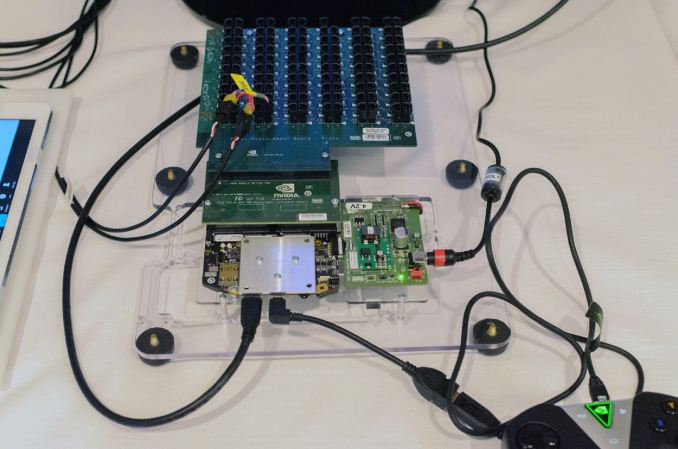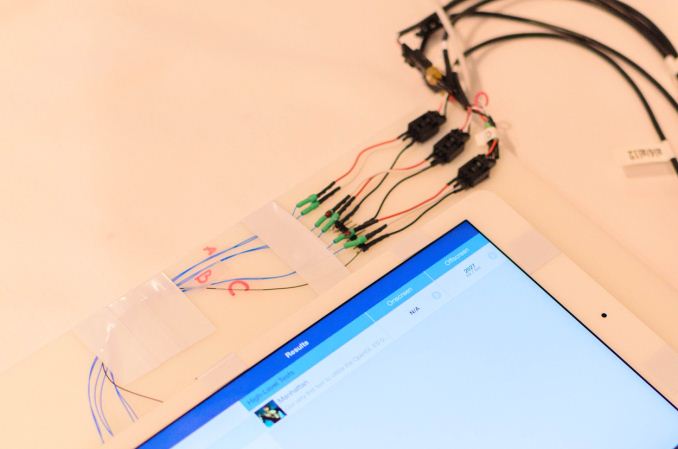NVIDIA Tegra X1 Preview & Architecture Analysis
by Joshua Ho & Ryan Smith on January 5, 2015 1:00 AM EST- Posted in
- SoCs
- Arm
- Project Denver
- Mobile
- 20nm
- GPUs
- Tablets
- NVIDIA
- Cortex A57
- Tegra X1
GPU Performance Benchmarks
As part of today’s announcement of the Tegra X1, NVIDIA also gave us a short opportunity to benchmark the X1 reference platform under controlled circumstances. In this case NVIDIA had several reference platforms plugged in and running, pre-loaded with various benchmark applications. The reference platforms themselves had a simple heatspreader mounted on them, intended to replicate the ~5W heat dissipation capabilities of a tablet.
The purpose of this demonstration was two-fold. First to showcase that X1 was up and running and capable of NVIDIA’s promised features. The second reason was to showcase the strong GPU performance of the platform. Meanwhile NVIDIA also had an iPad Air 2 on hand for power testing, running Apple’s latest and greatest SoC, the A8X. NVIDIA has made it clear that they consider Apple the SoC manufacturer to beat right now, as A8X’s PowerVR GX6850 GPU is the fastest among the currently shipping SoCs.
It goes without saying that the results should be taken with an appropriate grain of salt until we can get Tegra X1 back to our labs. However we have seen all of the testing first-hand and as best as we can tell NVIDIA’s tests were sincere.
| NVIDIA Tegra X1 Controlled Benchmarks | |||||
| Benchmark | A8X (AT) | K1 (AT) | X1 (NV) | ||
| BaseMark X 1.1 Dunes (Offscreen) | 40.2fps | 36.3fps | 56.9fps | ||
| 3DMark 1.2 Unlimited (Graphics Score) | 31781 | 36688 | 58448 | ||
| GFXBench 3.0 Manhattan 1080p (Offscreen) | 32.6fps | 31.7fps | 63.6fps | ||
For benchmarking NVIDIA had BaseMark X 1.1, 3DMark Unlimited 1.2 and GFXBench 3.0 up and running. Our X1 numbers come from the benchmarks we ran as part of NVIDIA’s controlled test, meanwhile the A8X and K1 numbers come from our Mobile Bench.
NVIDIA’s stated goal with X1 is to (roughly) double K1’s GPU performance, and while these controlled benchmarks for the most part don’t make it quite that far, X1 is still a significant improvement over K1. NVIDIA does meet their goal under Manhattan, where performance is almost exactly doubled, meanwhile 3DMark and BaseMark X increased by 59% and 56% respectively.
Finally, for power testing NVIDIA had an X1 reference platform and an iPad Air 2 rigged to measure the power consumption from the devices’ respective GPU power rails. The purpose of this test was to showcase that thanks to X1’s energy optimizations that X1 is capable of delivering the same GPU performance as the A8X GPU while drawing significantly less power; in other words that X1’s GPU is more efficient than A8X’s GX6850. Now to be clear here these are just GPU power measurements and not total platform power measurements, so this won’t account for CPU differences (e.g. A57 versus Enhanced Cyclone) or the power impact of LPDDR4.
Top: Tegra X1 Reference Platform. Bottom: iPad Air 2
For power testing NVIDIA ran Manhattan 1080p (offscreen) with X1’s GPU underclocked to match the performance of the A8X at roughly 33fps. Pictured below are the average power consumption (in watts) for the X1 and A8X respectively.
NVIDIA’s tools show the X1’s GPU averages 1.51W over the run of Manhattan. Meanwhile the A8X’s GPU averages 2.67W, over a watt more for otherwise equal performance. This test is especially notable since both SoCs are manufactured on the same TSMC 20nm SoC process, which means that any performance differences between the two devices are solely a function of energy efficiency.
There are a number of other variables we’ll ultimately need to take into account here, including clockspeeds, relative die area of the GPU, and total platform power consumption. But assuming NVIDIA’s numbers hold up in final devices, X1’s GPU is looking very good out of the gate – at least when tuned for power over performance.














194 Comments
View All Comments
GC2:CS - Monday, January 5, 2015 - link
And what happened ?kron123456789 - Monday, January 5, 2015 - link
What happend? Only custom-made by Apple GXA6850 can compete with K1 and there is no devices with GX6650. That happend.GC2:CS - Monday, January 5, 2015 - link
Tegra K1 is also custom-made.And A8X can not only compete, but what's more important, compete at a much lower power which matters more than just pure performance.
kron123456789 - Monday, January 5, 2015 - link
I mean that GXA6850 was made by Apple, it's not an ImgTec's design(which was GX6650). And A8X is 20nm SoC and this gives A8X efficiency advantage.GC2:CS - Monday, January 5, 2015 - link
Yeah GXA6850 is an semi-custom design.The efficiency adventage offered by 28 to 20 nm transition is only about 25%, the actual difference between k1 and A8X is much bigger.
techconc - Monday, January 5, 2015 - link
@kronI fail to see your point. Apple was able to put out a CPU/GPU that is both more powerful and more energy efficient than the nVidia based part. The original argument suggested that Apple should switch to nVidia. It's obvious from existing parts that there is no reason to do this. Your argument attempts to suggest otherwise, but fails to make the case. If we're basing the case off of future technology (like the X1) then you also need to discuss the Rogue 7 series chips that quite frankly look more impressive.
aenews - Saturday, January 24, 2015 - link
It is definitely more energy effcient and faster, but not significantly faster. They are on the same level, and there aren't games on iOS that even use that level of power right now.lucam - Tuesday, January 6, 2015 - link
Imgtec licenses design then anybody do what they want. It's the same of ARM with reference design and in house design (cyclone, denver etc). We are always talking about ARM. What the hell you re talking about?lucam - Tuesday, January 6, 2015 - link
Since there is no GX6650 around doesn't mean it cannot compete. Talking about speculations maybe an higher clock of GX6650 can compete who know. Apple did it's custom version, low clock and more cluster. Either way it's always PowerVr inside.kron123456789 - Monday, January 5, 2015 - link
And only compete. Not blows away, like somebody were saying.